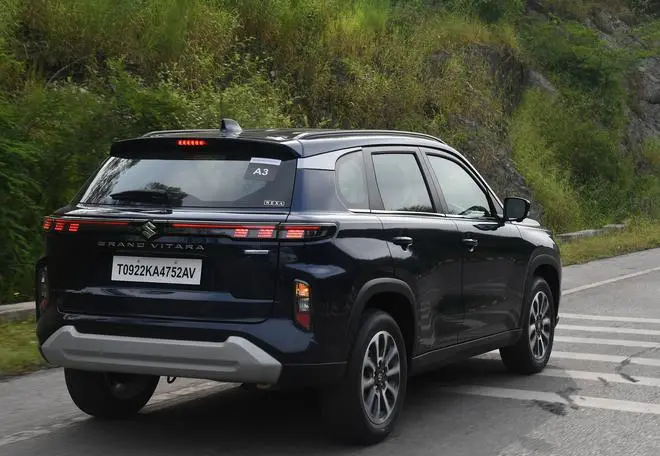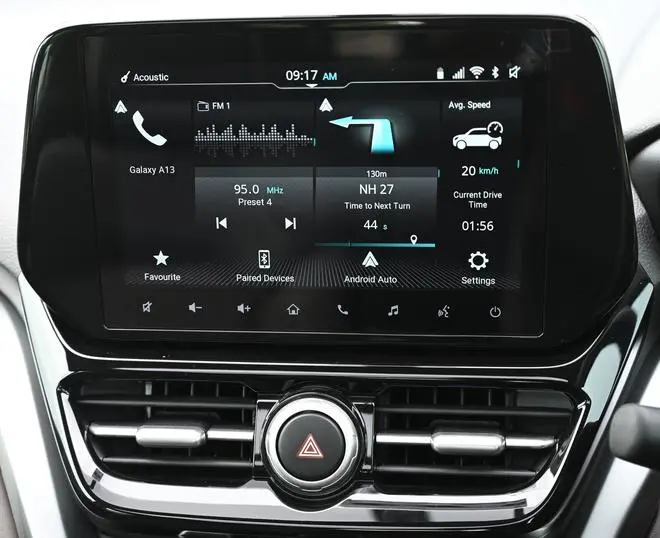A few weeks ago, I drove the Urban Cruiser Hyryder, the premium compact sports utility vehicle that Toyota has co-developed with Suzuki. The two Japanese car brands have brought together their strengths to create twin versions of the vehicle that can deliver volumes in a segment in which both the companies don’t have a presence currently in the Indian market. And unlike the obviously badge-engineered Suzukis bearing the Toyota logo-such as the Baleno and Glanza, and the Vitara Brezza and the Urban Cruiser-the new vehicles attempt a deeper differentiation between the two brands’ versions. However, under the skin, the twins are nearly identical. So, how does the Maruti Suzuki Grand Vitara fare?
Design
The premium compact SUV segment has seen a flurry of launches from newcomers and old-timers. It is one of the fastest growing segments, even within the SUV body-style category. And Maruti Suzuki’s only offering in the category has really been the sub-compact SUV Vitara Brezza (now Vitara). So, for Maruti, the new Grand Vitara is a key addition to its portfolio. This is a fairly large SUV, at a little over 4.3 metres in length and about 1.8 metres in width. But, like other Marutis, the Grand Vitara isn’t too heavy, with an average (of trim variants) kerb weight of about 1,250 kg. This Maruti and its Toyota twin sport the same wheelbase of 2.6 metres.

The vehicle’s rear design is easily the most appealing | Photo Credit: BIJOY GHOSH
Being a vehicle that was co-developed by the two car makers right from when it was conceived has helped create a unique design and fascia for the twins, especially for the exterior. There are body panels that are clearly shared by the two vehicles; in fact, that is the reason why the side profile is identical. But the front and rear of the Hyryder and the Grand Vitara get enough differentiation. It is good to see that Maruti has brought in a certain design integrity and language to the front profile. The dark chrome frame for the grille and the design of the grille itself offers an exclusive look to the Grand Vitara while giving brand identity too. The three-point LED DRLs connect this compact SUV with other NEXA vehicles. Both at the front and the rear, the big fenders feature elements like the fog lamps and housings that are shared but have still been smartly differentiated. The side profile is where the two brands’ cars look similar. It is also the angle where the length and size of the Grand Vitara really hits me. The fairly large overhangs and the classic SUV upright stance make this is a vehicle that is certainly out of the ordinary for Maruti. The 17-inch alloy wheels are unique to the Grand Vitara.
The vehicle’s rear design is easily the most appealing. The wide mid-section and the simple straight lines hint at the space in the cabin and add to the sense of size for the Grand Vitara. The connected tail-lamps sit on the haunches and deliver even more impact to the rear design. Maruti’s trim strategy for the Grand Vitara sees the ‘Smart Hybrid’ (Maruti powertrain) getting four variants and two loaded trim variants for the ‘Intelligent Hybrid’ (Toyota hybrid powertrain).
Cabin
The interior of the top trim variants that I drove was totally unlike any Maruti Suzuki vehicle that we have seen in the past. The quality of the cabins from Maruti’s NEXA brand vehicles has been progressively improving, and yet, the Grand Vitara’s delivers a much more premium impression. The two collaborating brands have chosen to present the more premium stitched leather and dual-tone cabin finish for each of their powertrain variants. And while the Hyryder hybrid variants’ cabin wore a black and chocolate colour theme, the Grand Vitara smart hybrid’s cabin sports a black and burgundy theme. The other highlight in the Grand Vitara (like in its twin) was the amount of space it offers for both front-seat and rear bench occupants.

The 7-inch digital MID (multi-info display) for the instrument cluster in the intelligent hybrid variants are very un-Maruti like | Photo Credit: BIJOY GHOSH
The materials used for the dashboard, IP, and the trim elements are premium to look at and touch, even though it is obvious that most of them are “faux” replacements—like the leatherette seat upholstery and the fake metal inserts. But, there are other features that are very un-Maruti-like, such as the ventilated seats, wireless charger, the 7-inch digital MID (multi-info display) for the instrument cluster in the intelligent hybrid variants, and the panoramic sunroof. Quite a few of these features will be variant-dependent. After the Baleno and the XL6, the Grand Vitara also gets the head-up display, which pops open and displays drive-related info, including turn-by-turn navigation. The 9-inch infotainment screen in the centre stack is loaded with Maruti’s latest SmartPlay Pro+ Interface; connectivity includes voice commands and wireless Apple CarPlay and Android Auto. There is also a suite of connected car features using the Suzuki Connect app.
Performance
The Maruti Suzuki Grand Vitara is being offered with two engines and three gearbox options. These are the same options that the Toyota Urban Cruiser Hyryder was offered with too. Here is where the two brands’ synergies have come to play. In the Grand Vitara, the ‘Intelligent Electric Hybrid’ variants are the ones that sport the TNGA (Toyota New Generation Architecture), 1.5-litre, 3-cylinder petrol engine. This Atkinson cycle engine is paired with a e-CVT (electronically controlled continuously variable transmission). This is a self-charging strong hybrid, so in addition to the petrol engine, there is also parallel and series assitance being offered by an electric motor on the front axle. The motor is powered by charge from a battery pack located under the floor and behind the rear occupants.
Though Maruti officials tell me that the Grand Vitara can deliver a combined driving range of 1,200km on a full tank of fuel, they also tell me that it is impossible to accurately define the battery-electric only range. That is because the battery is a relatively small, sub-one kW capacity pack of lithium-ion cells. The self-charging system uses regenerative braking and uses a proprietary algorithm to decide the level of assistance or even a pure EV mode range based on parameters like state of charge, vehicle speed, etc.

This hybrid powertrain feels peppy enough on the go | Photo Credit: BIJOY GHOSH
Combining the 3-cylinder engine’s output of 92.5PS and the e-motor’s 80PS, the total system generated output is 115.6PS and a notional peak torque of 163Nm during full parallel assistance. This hybrid powertrain feels peppy enough on the go, and even though a bit of 3-cylinder character comes through on the outside, in-cabin refinement is good.
The powertrain that Maruti has brought into the mix is the new generation K15C petrol engine. This 1,462cc unit delivers 103PS of peak power and 136.8Nm of torque. The engine is paired with either a 5-speed manual or a 6-speed torque converter automatic gearbox. This power unit is also offered with the option of AWD (only with the MT) . Its Suzuki AllGrip Select is an electronically controlled four-wheel drive system, with a controller scroll knob just below the gearstick allowing selection from four different modes-auto, sport, snow, and lock. To showcase the capabilities of the AWD, Maruti had created an off-road course with obstacles which were of moderately difficulty, and it was quite surprising to see a Maruti pull out of each one of them with ease. On the road, this engine feels quicker during the initial acceleration cycle. It sounds good too on the boil. This engine is rated to deliver a mileage of about 20kmph, while the one with the Toyota hybrid engine is rated to deliver about 28kmph.
Bottom Line
The new Grand Vitara is a completely fresh chapter for Maruti Suzuki. It helps the mass-market leader get into a segment in which it is a newcomer and is faced with formidable competitors. The fact that the new SUV is loaded with tech and features, and adds bits of novelty will certainly help take on these competitors. This will also be the first and only strong hybrid in the market currently adding to the appeal. But there is yet very little that differentiates the twins and it will eventually have to be brand loyalties and maybe trim strategies that will drive customers to choose one over the other. I expect Maruti to price the Grand Vitara in the ₹14 lakh to ₹18.5 lakh range.





Comments
Comments have to be in English, and in full sentences. They cannot be abusive or personal. Please abide by our community guidelines for posting your comments.
We have migrated to a new commenting platform. If you are already a registered user of TheHindu Businessline and logged in, you may continue to engage with our articles. If you do not have an account please register and login to post comments. Users can access their older comments by logging into their accounts on Vuukle.